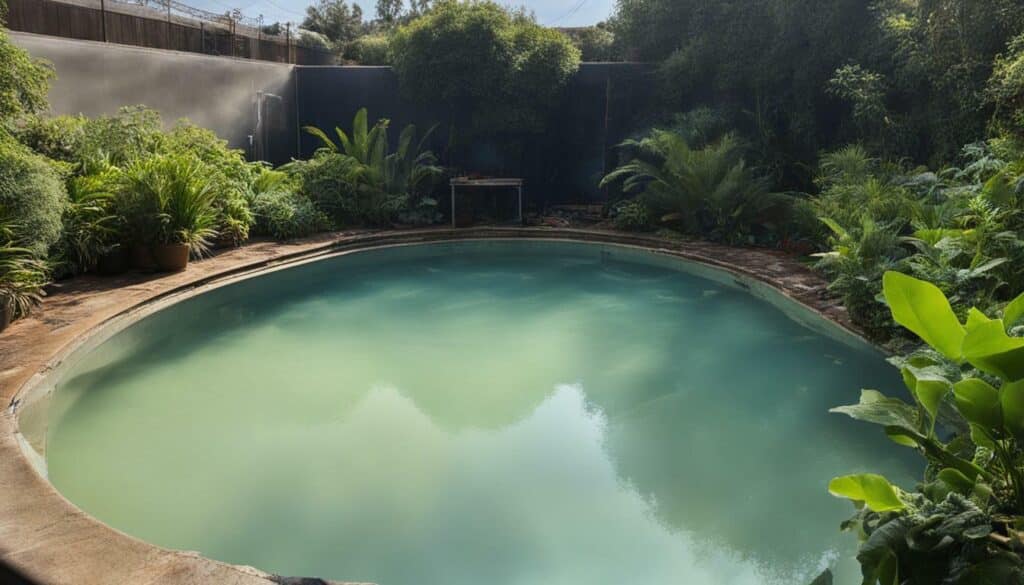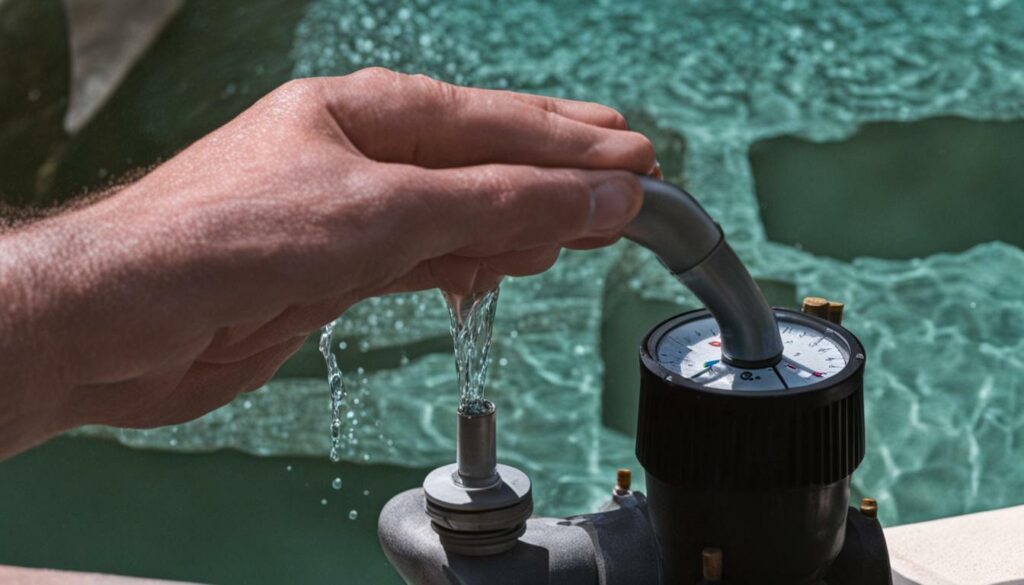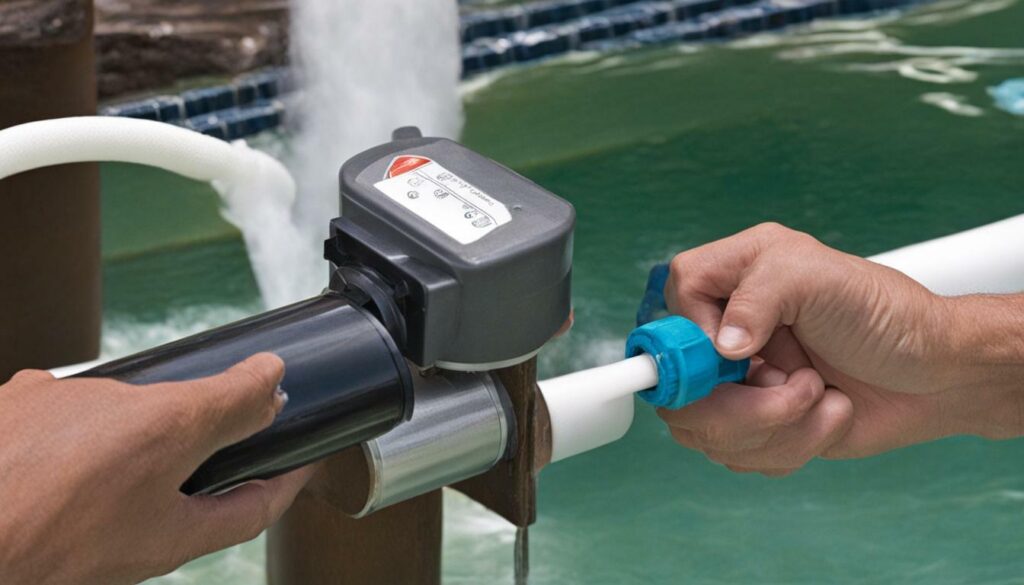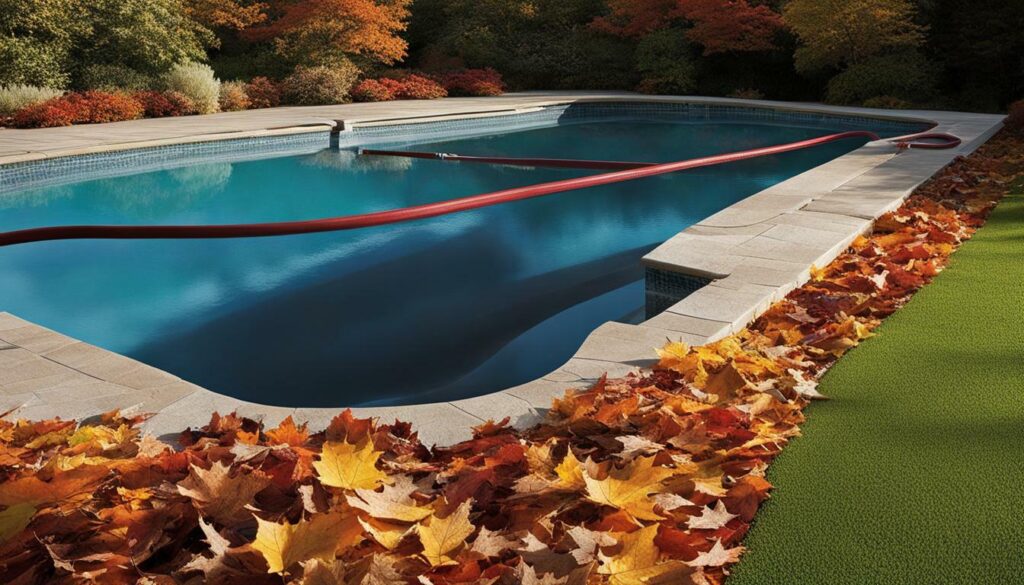
Winterizing your pool involves several crucial steps, and one of them is knowing how to blow out pool lines to prevent freezing and damage. This DIY guide will walk you through the easy steps to ensure your pool is properly prepared for the winter season.
Key Takeaways:
- Blowing out pool lines is an essential part of winterizing your pool.
- The process involves using air to remove all water from the system.
- Blowing out the lines prevents freezing and damage during the winter.
- You can perform a DIY pool line blowout with the right equipment.
- Hiring a professional pool service is an option for those who prefer assistance or want to observe the process.
Understanding the Pool Winterization Process
Before blowing out the pool lines, it is essential to properly winterize your pool by achieving the right chemical balance, shocking the pool, and completing other necessary tasks. Winterizing your pool is a crucial step in preserving its condition during the cold months and preventing any potential damage from freezing temperatures. By following the proper winterization process, you can protect your pool and ensure it is ready for use when warmer weather returns.
Pool winterization involves several key steps to prepare your pool for the winter season. Balancing the chemicals is the first step, ensuring that the pH level, alkalinity, and sanitizer levels are adjusted to the appropriate levels. This helps maintain the water quality and prevents the growth of bacteria and algae. Shocking the pool with a high dose of chlorine is also necessary to eliminate any remaining contaminants.
Once the chemicals are balanced and the pool is shocked, you can proceed with closing the pool. This includes removing any pool accessories and cleaning the pool thoroughly. It’s important to drain the water below the skimmer and return lines to prevent any damage caused by freezing. Finally, covering the pool with a properly fitted cover will provide an additional layer of protection from the elements.
By following these steps and ensuring proper winterization, you can maintain the integrity of your pool and avoid costly repairs or replacements in the future. Remember, blowing out the pool lines is just one part of the winterization process, but it is a critical step in preventing freezing and damage to the pool system.
Tools and Equipment for Pool Line Blowout
To blow out your pool lines, you’ll need specific tools and equipment designed for this task, such as a Shop Vac or air compressor. These tools will allow you to remove all the water from your pool system, ensuring it is properly winterized.
Using a Shop Vac or air compressor, you can apply air pressure to the pool lines, forcing out any remaining water and preventing freezing and damage during the winter months. The Shop Vac method is suitable for smaller pools, while an air compressor is more efficient for larger pools.
When choosing an air compressor, ensure it has enough power to generate sufficient air pressure for the job. Look for a compressor with a CFM (cubic feet per minute) rating of at least 6-8 to effectively blow out the lines. Additionally, consider using a pool winterizing kit that includes specialized attachments for connecting the air compressor to your pool lines.
| Tools and Equipment | Description |
|---|---|
| Shop Vac | A vacuum cleaner designed to remove water and debris from the pool lines. |
| Air Compressor | A device that generates high-pressure air to force the water out of the pool lines. |
| Pool Winterizing Kit | A kit that includes various attachments for connecting the air compressor to the pool lines. |
Before starting the pool line blowout process, it’s important to ensure that all necessary tools and equipment are in good working condition. Check for any leaks or damages that could affect the efficiency of the blowout. Taking the time to gather the right tools and equipment will make the process smoother and more effective.
Remember, blowing out your pool lines is an essential step in winterizing your pool and preventing potential damage. By using the correct tools and equipment, you can confidently tackle this DIY project and ensure your pool is properly prepared for the winter season.
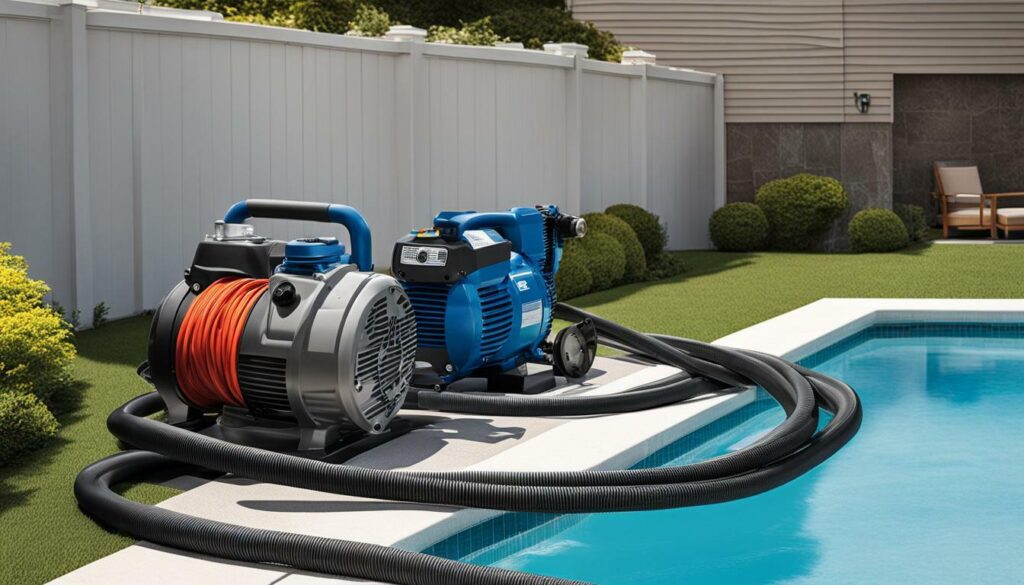
Follow these simple steps to successfully blow out your pool lines and prepare your pool for the winter season. Blowing out pool lines is an essential task to prevent freezing and damage during the colder months. By removing all the water from the system, you can ensure that your pool remains in good condition until the warmer weather returns.
Gather the necessary tools and equipment
Before beginning the process, make sure you have the right tools for the job. This may include a Shop Vac or an air compressor, depending on your preference. It’s important to use the correct equipment to ensure a thorough winterization.
Start with the suction side
The first step is to blow out the suction side of the pool lines. This includes the skimmer line and the main drain line. Attach the air compressor or Shop Vac to the appropriate line and blow air through the system. This will remove any water and debris that may be present.
Move on to the equipment side and pressure side
Once the suction side is clear, proceed to the equipment side of the pool lines. This includes the pump, filter, heater, and any other equipment connected to the pool lines. Blow air through each component to ensure all the water is removed.
Finally, move on to the pressure side of the pool lines. This includes the return lines and any other outlets where water circulates back into the pool. Use the air compressor or Shop Vac to blow air through each line, ensuring all the water is expelled.
| Suction Side | Equipment Side | Pressure Side |
|---|---|---|
| Skimmer line | Pump | Return lines |
| Main drain line | Filter |
By following these steps, you can successfully blow out your pool lines and ensure a well-prepared pool for the winter season. Remember to always prioritize safety and consider hiring a professional pool service if you are unsure or want to observe the process before attempting it yourself. With proper winterization, you can protect your pool and enjoy a hassle-free opening come spring.

While blowing out pool lines can be done as a DIY project, there are instances where hiring a professional pool service might be a better option. Pool blowout services offer expertise and experience that can ensure a thorough and efficient winterization process. They have the necessary knowledge to handle any challenges or issues that may arise, reducing the risk of damage to your pool system.
DIY pool line blowout, on the other hand, can be a cost-effective option for those who have the time, tools, and confidence to tackle the task themselves. It allows for greater control over the process and can be a rewarding experience for pool owners who enjoy taking care of their own maintenance tasks. However, it’s important to note that DIY blowouts require careful attention to detail and following the correct steps to prevent any potential damage to the pool system.
For those considering a DIY approach, it’s recommended to research and educate oneself thoroughly on the winterization process and the specific steps involved in blowing out pool lines. It’s also important to have the necessary equipment, such as a Shop Vac or air compressor, and to follow the manufacturer’s instructions for their proper use.
| DIY Pool Line Blowout | Professional Pool Blowout Services |
|---|---|
|
|
|
It’s important to note that while a DIY approach may save money, it carries the responsibility of ensuring all steps are followed correctly. Failure to do so could result in damage to your pool system. |
Professional pool blowout services provide peace of mind, knowing that your pool is being winterized by experienced professionals. They can handle any potential issues and ensure your pool is ready for the winter months. |
Ultimately, the decision between DIY and professional pool line blowout depends on individual circumstances and preferences. If you’re confident in your abilities and have the necessary tools, a DIY approach can be a rewarding and cost-effective option. However, if you’re uncertain or want to ensure a comprehensive winterization process, hiring a professional pool service is a wise investment.
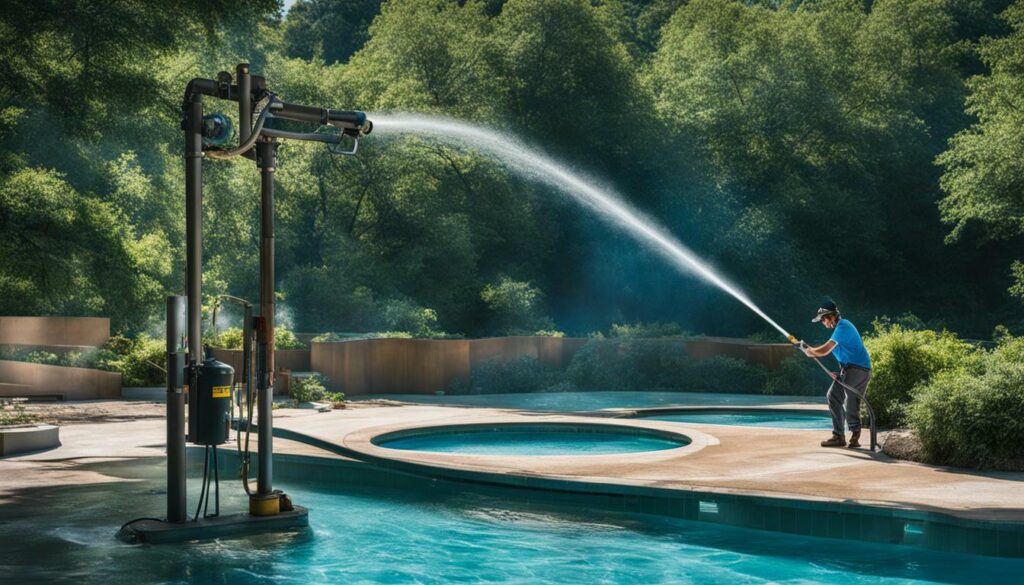
To make your pool line blowout a success, follow these helpful tips to avoid any complications and achieve effective winterization.
- Schedule enough time: Winterizing your pool and blowing out the lines requires ample time, so be sure to set aside a few hours to complete the process. Rushing through it can lead to mistakes and increased risk of freezing or damage.
- Use the correct air pressure: It’s important to use the appropriate air pressure when blowing out pool lines. Too much pressure can damage the plumbing, while too little pressure may not effectively remove all the water. Consult your pool’s manufacturer guidelines or seek advice from a professional for the recommended air pressure.
- Check for leaks: Before blowing out the lines, inspect the entire system for any leaks or weak spots. Fixing these issues prior to winterization will ensure that the air pressure is effective and that your pool remains well-preserved throughout the season.
Remember, safety should always be a priority when performing a pool line blowout. Wear protective eyewear, gloves, and clothing to shield yourself from potential debris or accidents. If you’re unsure about any aspect of the process, don’t hesitate to reach out to a professional pool service or seek guidance from experienced pool owners. With proper planning, the right equipment, and attention to detail, you can successfully blow out your pool lines and protect your investment during the winter months.
“Winterizing your pool and blowing out the lines requires ample time, so be sure to set aside a few hours to complete the process.”
For a visual guide on how to blow out pool lines, refer to the image below:
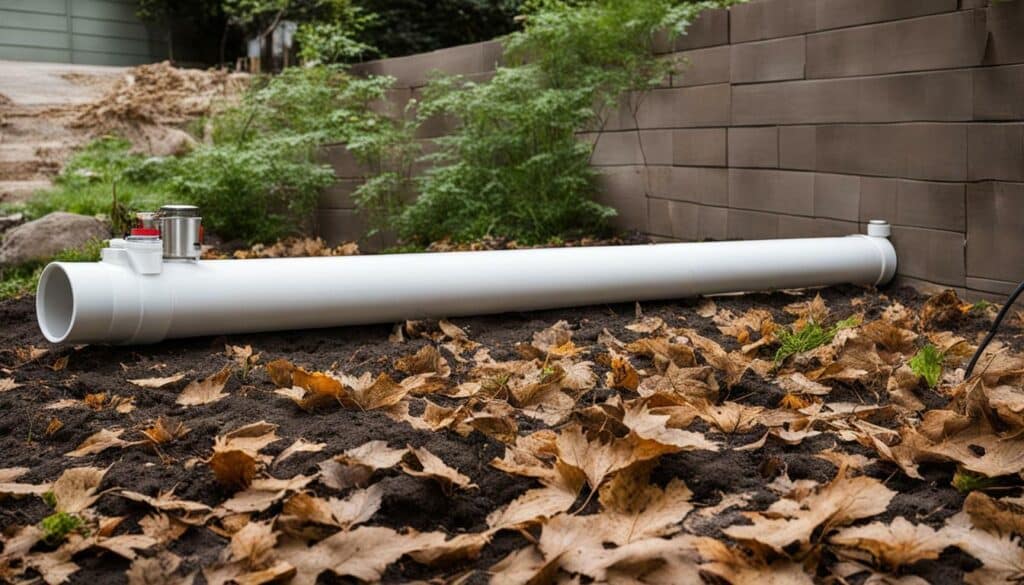
| Key Tips: | Benefits: |
|---|---|
| Plan enough time to complete the process | Prevent freezing and damage to your pool |
| Use the correct air pressure | Ensure effective removal of water from the system |
| Check for leaks before blowing out the lines | Maintain a well-preserved pool during winter |
Safety Precautions When Blowing Out Pool Lines
Prioritize safety by following these essential precautions when blowing out your pool lines to avoid accidents and injuries.
1. Turn off power: Before starting the blowout process, make sure to turn off the power to the pool pump. This will prevent any potential accidents or damage to the electrical system.
2. Wear protective gear: It is important to wear protective gear, such as safety goggles and gloves, to protect yourself from debris and potential injury while working with the pool lines.
3. Release pressure: Before disconnecting any fittings or valves, release the pressure from the pool lines by opening the air relief valve. This will prevent any sudden bursts of air or water that could cause harm.
4. Use caution with air pressure: When using an air compressor or Shop Vac to blow out the lines, be cautious with the air pressure. Too much pressure can damage the pool lines, while too little pressure may not effectively remove all the water.
5. Work in pairs: It is always recommended to have a helper nearby when blowing out pool lines. This ensures that someone is available to assist in case of emergencies or if additional hands are needed.
Remember, safety should always be the top priority when performing any maintenance or winterization tasks on your pool. By following these precautions, you can ensure a smooth and safe pool line blowout process.
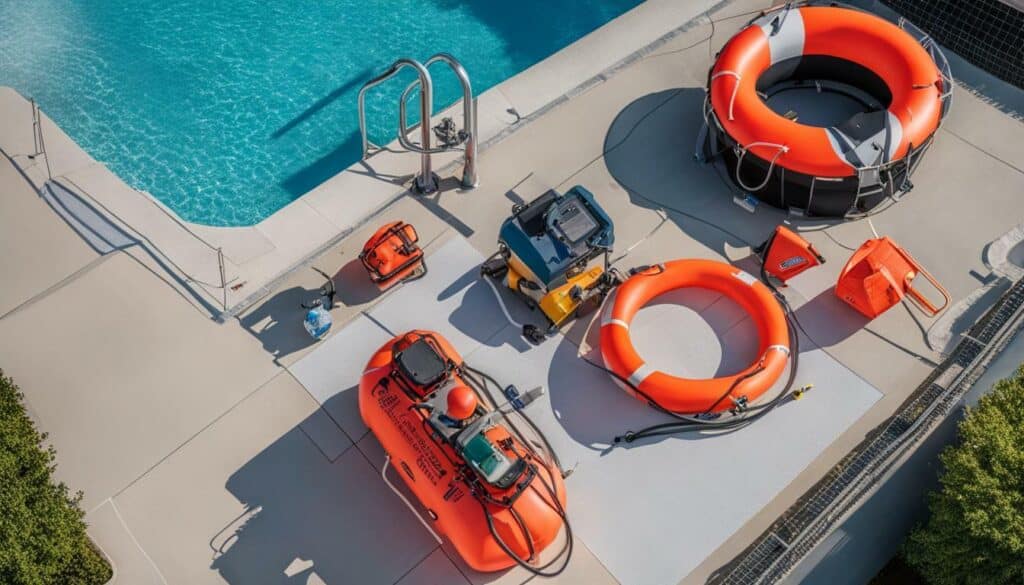
Even during the winter season, it is important to maintain your pool’s condition. Follow these tips to keep your pool well-preserved throughout the winter months.
1. Monitor water level: Regularly check the water level of your pool to ensure it stays at the appropriate level. Excessive evaporation or heavy rainfall can cause fluctuations, so be prepared to make adjustments as needed.
| Month | Water Level |
|---|---|
| December | Keep water level at midpoint of skimmer opening. |
| January | Water level should be a few inches below skimmer opening. |
| February | Keep water level consistent with January. |
2. Inspect your pool cover: Ensure your pool cover is securely in place to protect your pool from leaves, debris, and snow. Use a pool cover pump to remove any standing water on top of the cover to prevent excessive weight and damage.
3. Keep an eye on chemical levels: Although you won’t be using your pool during the winter, it’s important to maintain proper chemical balance. Test the water regularly and adjust chemicals as needed to prevent algae growth and keep the water clean.
4. Periodic inspection: Take the time to inspect your pool equipment, such as the filter, pump, and heater, throughout the winter. Look for any signs of damage or malfunction and address them promptly to avoid expensive repairs or replacements come springtime.
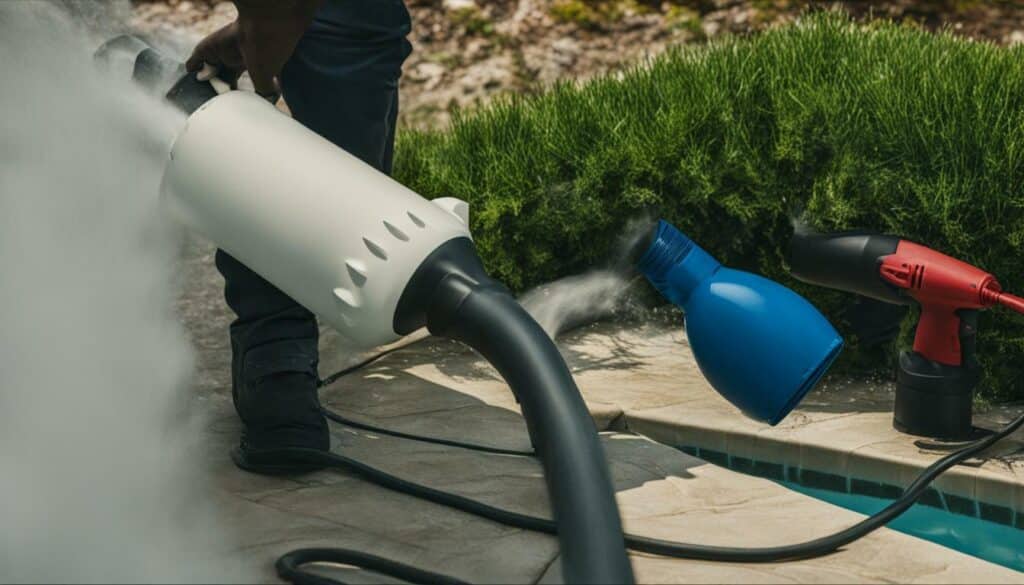
Following these tips will help you ensure that your pool remains in good condition during the winter months. By taking proper care of your pool, you’ll be ready to dive back in when the warmer weather returns.
Troubleshooting Common Pool Line Blowout Issues
Encountering issues during the pool line blowout process is not uncommon. Here are some troubleshooting tips to help you resolve common problems and achieve a successful winterization:
1. Low air pressure: If you notice that the air pressure is too low, it may indicate a problem with your equipment or a blockage in the lines. Check the air compressor or Shop Vac for any issues and ensure that the equipment is properly connected. If there is a blockage, try using a pipe snake or a long auger to clear the lines before proceeding.
2. Leaks in the lines: Leaks can occur during the blowout process, especially if the pool lines have not been properly maintained. Inspect the lines for any signs of leaks, such as dripping water or hissing sounds. If you find a leak, use plumber’s tape or silicone caulking to seal it. It’s important to fix any leaks before proceeding to prevent water from entering the lines during winter.
3. Water still remains in the lines: If you find that water is still present in the lines after blowing them out, it may indicate that the process was not done thoroughly enough. Double-check that you followed the correct sequence of blowing out the suction side, equipment side, and pressure side. It’s also essential to ensure that you allow enough time for the air to completely remove all water from the lines.
Table: Common Pool Line Blowout Issues
| Issue | Troubleshooting Solution |
|---|---|
| Low air pressure | Check equipment and clear blockages |
| Leaks in the lines | Inspect and seal any leaks |
| Water still remains in the lines | Follow the correct sequence and allow sufficient time for the blowout |
Remember, if you encounter any major issues or are unsure about the blowout process, it’s always a good idea to consult with a professional pool service. They have the expertise and experience to ensure a thorough winterization and prevent any potential damage to your pool.
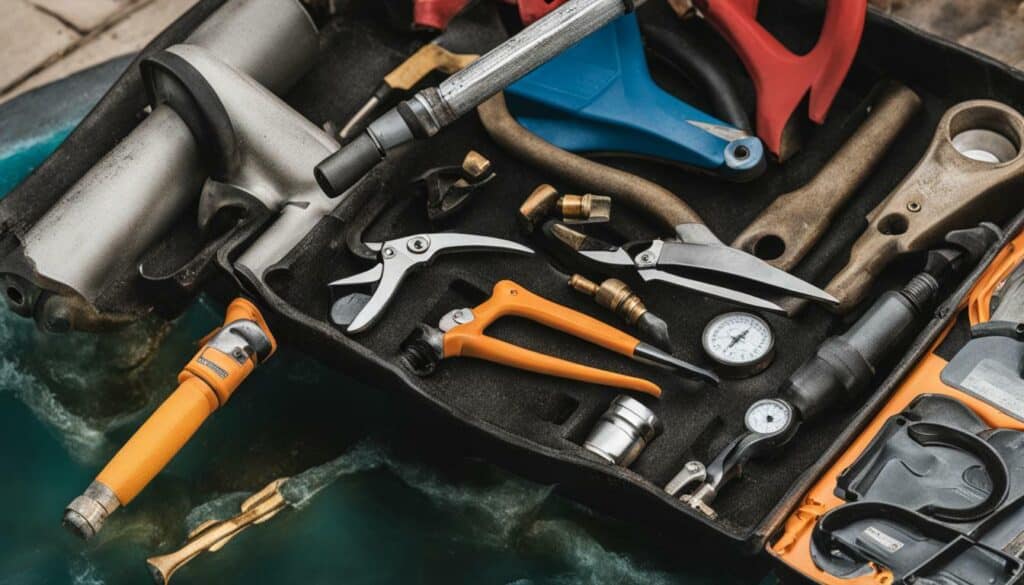
By troubleshooting common pool line blowout issues, you can achieve a successful winterization and protect your pool from freezing and damage. Following the correct sequence, using the right equipment, and addressing any leaks or low air pressure will help ensure a smooth blowout process. Remember, safety is paramount, so always follow the necessary precautions and take your time to properly winterize your pool.
Tips for Efficient Pool Line Blowout
Increase the efficiency of your pool line blowout process with these helpful tips that will save you time and yield better results.
1. Start early: It’s best to begin the pool line blowout process well before the temperature drops below freezing. This allows you ample time to complete the task without rushing and ensures that your pool lines are properly winterized.
2. Have a clear plan: Before starting the blowout, make sure you have a clear plan in place. Familiarize yourself with the steps involved and gather all the necessary tools and equipment. This will help streamline the process and prevent any delays or confusion.
“Blowing out pool lines is a crucial step in winterizing your pool to prevent freezing and damage.”
3. Maintain equipment: Regularly maintaining your equipment is essential for a smooth pool line blowout. Clean and check your air compressor or Shop Vac before use to ensure they are functioning properly. This will help avoid any interruptions or breakdowns during the process.
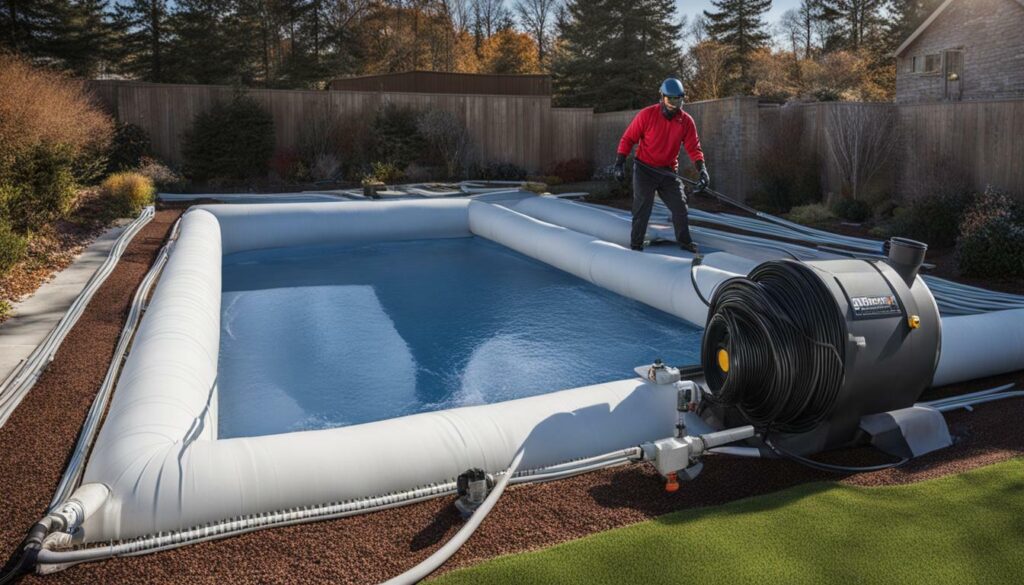
4. Stay organized: Keep track of the steps you’ve completed and the areas you’ve blown out to maintain an organized approach. This will help you avoid missing any sections and ensure a thorough winterization of your pool lines.
Follow these tips to maximize the efficiency of your pool line blowout process. By starting early, having a clear plan, maintaining your equipment, and staying organized, you’ll be well-prepared to protect your pool from freezing and potential damage during the winter months.
| Tips for Efficient Pool Line Blowout: |
|---|
| Start early |
| Have a clear plan |
| Maintain equipment |
| Stay organized |
Conclusion
By following this easy step-by-step guide and mastering the technique of blowing out pool lines, you can confidently winterize your pool and protect it from freezing and damage. Blowing out pool lines is an essential part of the overall winterization process, ensuring that no water remains in the system that could potentially freeze and cause costly damage.
Before blowing out the lines, it’s crucial to achieve the right chemical balance and shock the pool, along with completing other closing tasks. This ensures that your pool is in the best possible condition for the winter months. Once these steps are completed, it’s time to remove all the water from the lines.
To blow out the pool lines, you have the option of using a Shop Vac or an air compressor. The air should be blown through the suction side, equipment side, and pressure side of the system, following the correct order and sequence. By using the right tools and following the proper technique, you can effectively remove all the water from the lines, keeping your pool safe throughout the winter season.
If you’re unsure about doing the pool line blowout yourself, or if you simply want to observe the process before attempting it, hiring a professional pool service is always an option. They have the expertise and experience to ensure a thorough winterization, giving you peace of mind knowing that your pool is properly prepared for the colder months.
FAQ
Q: Why is blowing out pool lines important?
A: Blowing out pool lines is important to prevent freezing and damage during the winter. It ensures that the pump is not running and removes all water from the system.
Q: Can I do the pool line blowout myself?
A: Yes, the pool line blowout can be done as a DIY project. You can use a Shop Vac or air compressor to blow out the lines.
Q: In what order should I blow out the pool lines?
A: The correct order for blowing out pool lines is suction side, equipment side, and pressure side of the system. Following this sequence ensures thorough winterization.
Q: What tools and equipment do I need for pool line blowout?
A: You will need a Shop Vac or air compressor to blow out the lines. It’s important to use the correct equipment for the job.
Q: Should I hire a professional pool service for the blowout?
A: Hiring a professional pool service is an option for those who are unsure or want to observe the process before trying it themselves. It can provide peace of mind and ensure the job is done correctly.
Q: Are there any safety precautions I should take when blowing out pool lines?
A: Yes, it’s important to take safety precautions when blowing out pool lines. This includes wearing protective gear, following instructions carefully, and being cautious of potential hazards.
Q: What are some tips for an efficient pool line blowout?
A: To ensure an efficient pool line blowout, start early, have a clear plan, and properly maintain your equipment. These measures can save time and ensure thorough water removal.
Q: How do I troubleshoot common pool line blowout issues?
A: If you encounter common issues during the pool line blowout process, such as leaks or low air pressure, consult troubleshooting advice. This will help you overcome challenges and achieve a successful winterization.
Q: How can I maintain a well-preserved pool during winter?
A: To maintain a well-preserved pool during winter, cover the pool, monitor water levels, and periodically inspect for any issues. These measures will help keep your pool safe and ready for use in the next season.


